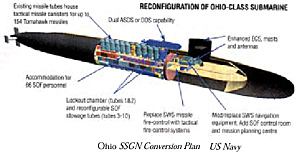 The US Navy will convert two Ohio-class ballistic missile submarines to an SSGN configuration. USS Michigan and USS Georgia will have their Trident missiles removed and their silos adapted to carry Tomahawk missiles (up to 154) and special warfare personnel (up to 102).
The US Navy will convert two Ohio-class ballistic missile submarines to an SSGN configuration. USS Michigan and USS Georgia will have their Trident missiles removed and their silos adapted to carry Tomahawk missiles (up to 154) and special warfare personnel (up to 102).
Ohio SSGN Conversion Plan US Navy
Originally, four subs were to have been converted. These are the four oldest Tridents, and are to be retired from strategic service as part of the START II treaty. Under that agreement, the US can only operate 14 Trident SSBNs. The boats to be decommissioned are USS Ohio (SSBN-726) and Florida (SSBN-728) in 2002, and Michigan (SSBN-727) and Georgia (SSBN-729) in 2003. Although the oldest of the Tridents, they still have over twenty years of life left in their hulls. It was decided to convert only two of the boats, although others may be added if the conversion is successful. As it is, the program will cost $1.9 billion.
Work will start in October of 2003. If the work proceeds on schedule, the boats will be ready for testing in 2007 and join the fleet in 2008. Twenty-two of the boomers’ 24 Trident missile tubes will be adapted to hold a “Multi All-Up Round Canister” (MAC) that can hold seven Tomahawk missiles. It could fire all 154 missiles in six minutes.
The sub will be able to carry almost any version of the Tomahawk, including the Tomahawk Block IV or the projected Tactical Tomahawk. It will not be able to carry the nuclear TLAM-N.
Because the Tomahawk missiles are shorter than the Trident missiles (by twenty feet), the shorter missile tubes will free up an additional deck underneath. This space will be used for berthing up to 66 SOF troops and to stow their equipment and ordnance. Tubes 1 and 2 of the 24 (farthest forward) will be permanently converted to nine-man lockout chambers for divers. Advanced SEAL Delivery Systems (ASDS) minisubs and Dry Deck Shelters can be mated to the sub at the tops of these two tubes. Either two ASDS or two dry deck shelters or one of each can be carried on the top of the hull.
Alternatively, tubes three through ten can hold SOF equipment and ordnance, still leaving space for 98 Tomahawk missiles (14 MACs). An additional 36 SEALs could be tempo-rarily berthed in the torpedo room and the missile compartment. This radical refit will allow the sub to take the place of a carrier battle group in many situations. Its Tomahawk missiles will allow it to deliver a devastating strike and its SOF troops (up to four platoons) could strike important targets, perform reconnaissance missions, or even act as forward observers for the sub’s missiles, picking aim points, observing their effects, and calling in follow-on attacks.
An Improved Los Angeles boat might carry 16 - 20 Tomahawk, 12 in her VLS and another 4 to 8 in place of torpedoes. An Arleigh Burke destroyer, trading SAMs for Tomahawks, could carry between 20 to 40 missiles. A VLS Spruance could devote all her cells to Tomahawks, allowing for up to 64 missiles. An Ohio SSGN could thus replace the Tomahawk assets of a carrier battle group, and do it as covertly as an Improved Los Angeles class.
Where these missiles will come from remains an unresolved issue. As of this writing, the US has approximately five hundred Tomahawk missiles in its inventory. Thus, each of the Ohio SSGNs can carry almost a third of the nation’s total.
Keeping a single SSGN on patrol near a potential trouble spot is much easier than supporting a carrier battle group in the same location, and would be much less provocative. An opponent would not even know the boat was there, unless we chose to tell him. As part of the conversion, the boats will be refueled. To support their new assets, each boat will have a dedicated secure SOF planning center, presumably with the ability to receive, store and display intelligence needed for SOF operations.
It will also have a Tomahawk mission planning center, replacing the ballistic missiles’ control center. This gives the sub the ability to plan its own missile strikes.
The subs will also have their ESM systems upgraded to the BLQ-10(v)2 suite, and will receive a new periscope, and new navigation and communications suites. The sonars would also receive some minor improvements. Future growth options include new versions of the Tomahawk, or the Advanced Land Attack Missile (ALAM), or other weapons. Additionally, the boat could be fitted with UAVs when the technology matures.
BT
Back to The Naval Sitrep #21 Table of Contents
Back to Naval Sitrep List of Issues
Back to MagWeb Master Magazine List
© Copyright 2001 by Larry Bond and Clash of Arms.
This article appears in MagWeb (Magazine Web) on the Internet World Wide Web.
Other military history and related articles are available at http://www.magweb.com